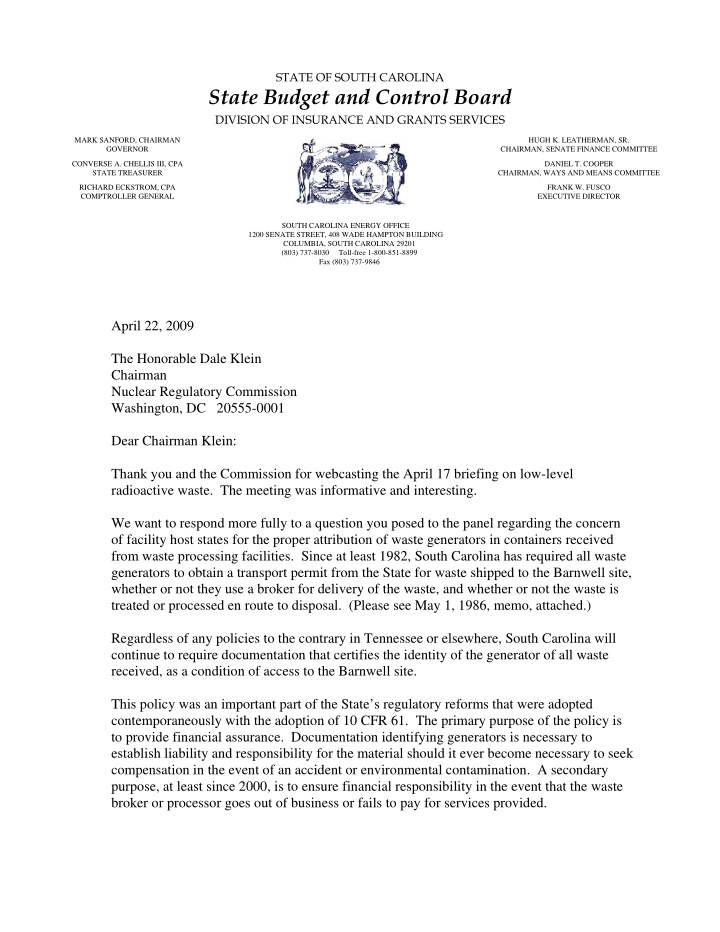



STATE OF SOUTH CAROLINA State Budget and Control Board DIVISION OF INSURANCE AND GRANTS SERVICES MARK SANFORD, CHAIRMAN HUGH K. LEATHERMAN, SR. GOVERNOR CHAIRMAN, SENATE FINANCE COMMITTEE CONVERSE A. CHELLIS III, CPA DANIEL T. COOPER STATE TREASURER CHAIRMAN, WAYS AND MEANS COMMITTEE RICHARD ECKSTROM, CPA FRANK W. FUSCO COMPTROLLER GENERAL EXECUTIVE DIRECTOR SOUTH CAROLINA ENERGY OFFICE 1200 SENATE STREET, 408 WADE HAMPTON BUILDING COLUMBIA, SOUTH CAROLINA 29201 (803) 737-8030 Toll-free 1-800-851-8899 Fax (803) 737-9846 April 22, 2009 The Honorable Dale Klein Chairman Nuclear Regulatory Commission Washington, DC 20555-0001 Dear Chairman Klein: Thank you and the Commission for webcasting the April 17 briefing on low-level radioactive waste. The meeting was informative and interesting. We want to respond more fully to a question you posed to the panel regarding the concern of facility host states for the proper attribution of waste generators in containers received from waste processing facilities. Since at least 1982, South Carolina has required all waste generators to obtain a transport permit from the State for waste shipped to the Barnwell site, whether or not they use a broker for delivery of the waste, and whether or not the waste is treated or processed en route to disposal. (Please see May 1, 1986, memo, attached.) Regardless of any policies to the contrary in Tennessee or elsewhere, South Carolina will continue to require documentation that certifies the identity of the generator of all waste received, as a condition of access to the Barnwell site. This policy was an important part of the State’s regulatory reforms that were adopted contemporaneously with the adoption of 10 CFR 61. The primary purpose of the policy is to provide financial assurance. Documentation identifying generators is necessary to establish liability and responsibility for the material should it ever become necessary to seek compensation in the event of an accident or environmental contamination. A secondary purpose, at least since 2000, is to ensure financial responsibility in the event that the waste broker or processor goes out of business or fails to pay for services provided.
Attribution of waste to the original generator has been one of the pillars of regulatory policy on low-level radioactive waste. When SEG, Inc., first proposed a supercompactor in the State of Tennessee, representatives of the company visited South Carolina to ensure the State that they were supportive of the policy and would identify all generators whose waste contributed to comingled packages. For purposes of federal surcharge rebates in the early 1990s, the Department of Energy required that waste shipped through brokers and processors provide a breakdown of volumes in all comingled packages. We continue to believe that documentation accurately attributing waste to the original generators is an important regulatory policy and know of no constructive purpose that would be served in omitting such information on shipping manifests. We believe that the NRC can take a lead role in ensuring consistency in its implementation of this policy among the states. Sincerely, William Newberry Manager Radioactive Waste Disposal Program Richard A. Haynes, P.E., Director Division of Waste Management Bureau of Land and Waste Management S.C. Dept. of Health and Environmental Control Enclosure: As stated
Recommend
More recommend